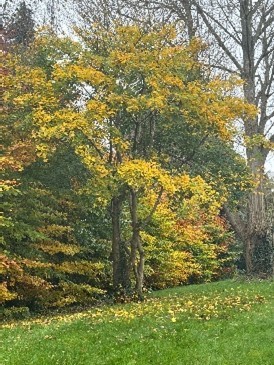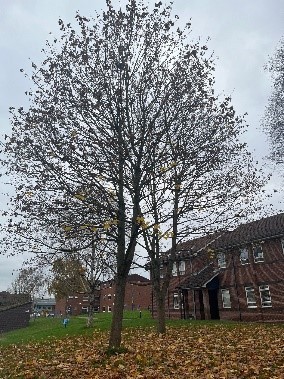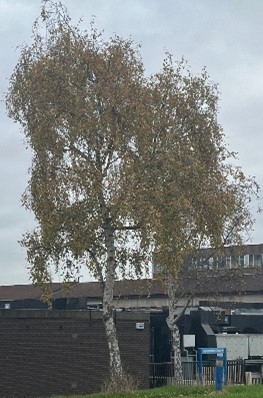
In early 2025, we will be opening a short 'wild walk' around Lewes House to share information about these trees and our work to reach carbon net zero, in line with a national ambition to deliver the world’s first net zero health service and respond to climate change, improving health now and for future generations.
The trees which are on display throughout this wild walk will:
- Produce 115 tonnes of Oxygen
- Allow 124,253 people to breathe for an entire day
- Store 43 tonnes of carbon
You can find out more about the different types of trees we have using the dropdown menus below.
The Woodland Trust have a Tree ID App if you want to know more which includes an A-Z of trees in your pocket.
The Ash is one of the most common trees in the UK and, when fully mature, can reach a height of 35m. It is tall, with pale brown to grey parks and fissures as the tree matures. In winter, the tree has black flattened twigs and buds. The leaves are oval and light green, and they fall in the autumn while they are still green. The flowers grow long fruits in late summer and autumn until they fall in winter.
|
Tag No |
Height |
Canopy Spread |
Maturity |
Age (approx) |
|
97 |
15m |
14m |
Mature |
69 |
The deciduous Oak can grow up to 40m tall. Their leaves are around 10cm long with 4-5 lobes with smooth edges, Leaf burst occurs mid may and the leaves grow in bunches. They have long yellow catkins and have features green acorns that grow up to 2.5cm which falls when they turn brown.
|
Tag No |
Height |
Canopy Spread |
Maturity |
Age (approx) |
|
94 |
15m |
11m |
Semi Mature |
86 |
|
98 |
15m |
15m |
Mature |
106 |

|
Tag No |
Height |
Canopy Spread |
Maturity |
Age (approx) |
|
93 |
9m |
6m |
Semi Mature |
38 |
|
100 |
9m |
7m |
Mature |
43 |

|
Tag No |
Height |
Canopy Spread |
Maturity |
Age (Approx) |
|
95 |
8m |
6m |
Semi Mature |
42 |
|
101 |
15m |
11m |
Mature |
80 |
|
102 |
13m |
7m |
Semi Mature |
46 |
|
105 |
10m |
9m |
Mature |
51 |
|
106 |
12m |
11m |
Semi Mature |
65 |
There are two types of Poplar, Black and White.
The tall Black poplar is a rare sight these days but can live up to 200 years and grow up to 30m tall. The bark is dark brown/black and the knobbly twigs are brown. The leaves are shiny, green and heart-shaped. Younger leaves are also covered in tiny hairs which are shed in Autumn. The flowers are catkins (red male and yellow/green female).
The white poplar has rounded leaves compared to the black poplar. This can grow to 20m and has pale grey bark and white twigs. Young twigs have a covering of dense white hair that lasts until their second year.
|
Tag No |
Height |
Canopy Spread |
Maturity |
Age (approx.) |
|
99 |
19m |
13m |
Mature |
121 |

|
Tag No |
Height |
Canopy Spread |
Maturity |
Age (Approx) |
|
103 |
9m |
6m |
Semi Mature |
38 |
|
104 |
12M |
9m |
Mature |
72 |
|
107 |
10m |
8m |
Mature |
59 |
|
108 |
10m |
6m |
Semi Mature |
53 |
|
109 |
8m |
7m |
Semi Mature |
43 |
This is the largest species of willow, with mature trees growing up to 25m. They often have a leaning crown. Their bark is grey/brown and develops deep fissures with age. The twigs are also grey/brown, with long oval leaves covered with fine silvery hairs on the underside. In the spring, they have catkins.
|
Tag No |
Height |
Canopy Spread |
Maturity |
Age (approx) |
|
96 |
17m |
17m |
Mature |
40 |
The Woodland Trust have a Tree ID App if you want to know more which includes a helpful A-Z of trees, including those which can be seen at George Eliot Hospital NHS Trust.